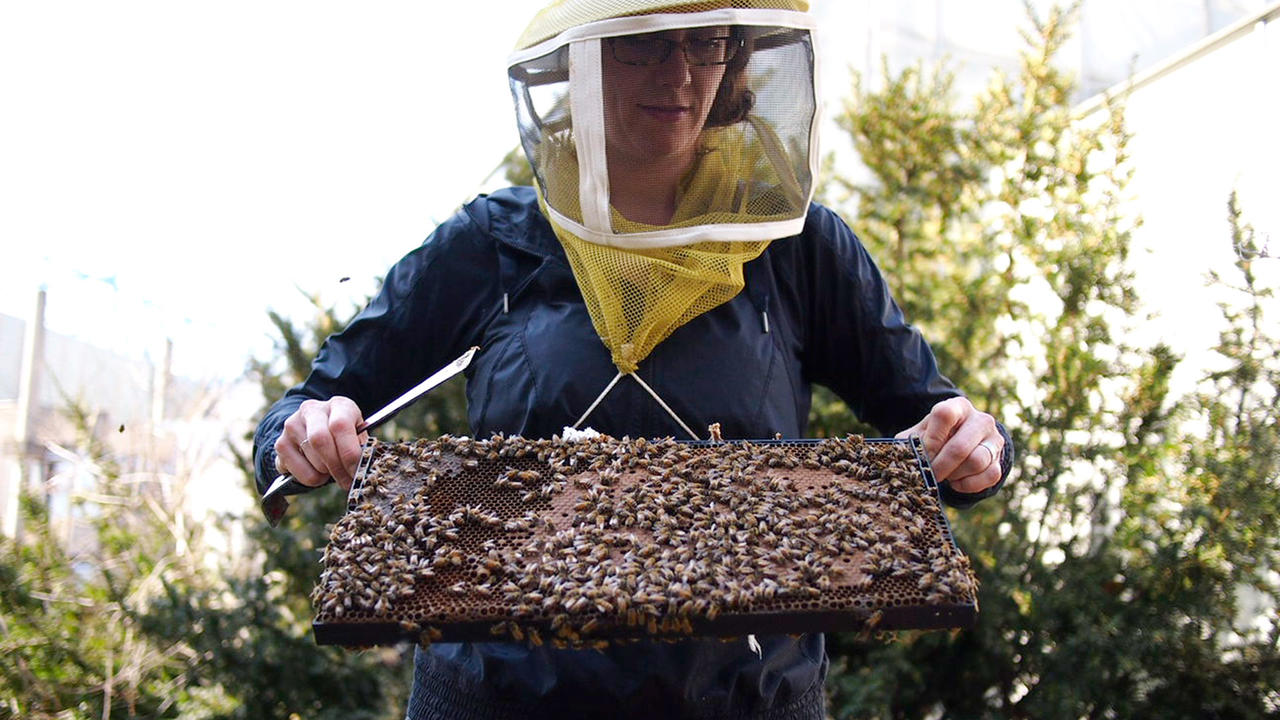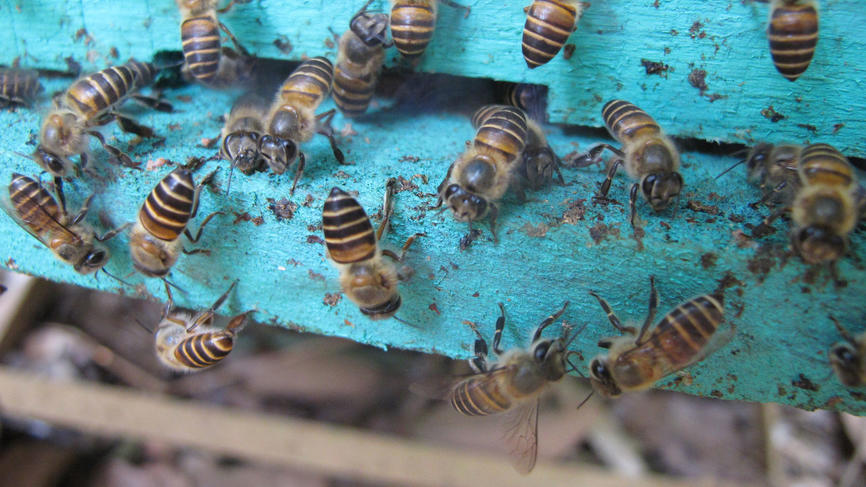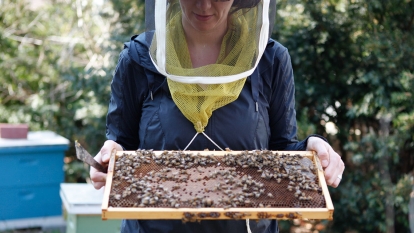
How Honey Bees Use Animal Poop as a Chemical Weapon to Protect Their Hives from Giant “Murder” Hornets
Heather Mattila stood in the middle of a chicken coop at the rural Ba Trai Commune 60 miles west of Hanoi, Vietnam, watching to see if the Asian honey bees (Apis cerana) she was researching would indeed forage for animal feces, as a local beekeeper had previously mentioned to a member of her research team.
Seven years later, Mattila, associate professor of biological sciences at Wellesley, and an international team of researchers are now the first scientists to document that honey bees forage for animal dung and then use it as a tool—a chemical weapon of sorts—to defend their hives from giant hornet (Vespa soror) attacks.
“Not only have we documented the first example of tool use by honey bees in nature,” Mattila said, “but the act of foraging for feces itself is another documented first for honey bees.” Honey bees routinely forage for materials produced by plants (such as nectar, pollen, and resin), but have not been known previously to collect solid materials from any other source. They occasionally collect fluids from animal waste, which can provide them with needed salts, but this is the first time they have been seen collecting solid pieces of dung, carrying it home with their mouthparts, and applying it to the entrance of their nests (called “fecal spotting”).
“We documented that hornets were less likely to land on entrances or chew their way into hives when there were more fecal spots around entrances,” Mattila said of their findings, which were recently published in the journal PLOS ONE, and covered in The New York Times and The Guardian. “While further research is needed to determine exactly what properties of animal feces repel the hornets, the barrier the bees create is an effective defense against their attacks.”
“Not only have we documented the first example of tool use by honey bees in nature, but the act of foraging for feces itself is another documented first for honey bees.”
Heather Mattila
Mattila and her fellow researchers have studied interactions between giant hornets and Asian honey bees in Vietnam since 2013. Funded by the National Geographic Society’s Committee for Research and Exploration, the Vietnam Academy of Science and Technology, and Wellesley College’s Knafel Chair in the Natural Sciences and the Summer Research Program, the team conducted their fieldwork in apiaries with colonies that are managed by local beekeepers and housed in wooden hives.
First, the researchers wanted to confirm that the honey bees collect animal dung, then they set out to document and quantify how they used it and what effect it had. The first step involved visiting local farmers to see if bees from the study apiaries were interested in their livestock’s waste. After observing bees as they collected dung time in the chicken coop, Mattila and her colleagues created a “dung buffet” beside their most active study apiary. Over the course of several days, the researchers paint-marked many bees while they were retrieving dung, then traced them back to their hives, where they watched the bees plastering the dung around their entrances.
The team then began tracking how the bees built up their defenses using feces in response to attacks by giant hornets. They found that bees began fecal spotting after being attacked and continued to do so for several days. The bees’ behaviors decreased the severity of attacks by repelling giant hornets from nest entrances, where they focused their attacks, often in groups.
The team found that honey bees also collected dung even if they had not yet been attacked but had been exposed to the chemicals released by hornet scouts and that Asian honey bees did not use this animal dung defense against smaller, less deadly hornet species.
“While further research is needed to determine exactly what properties of animal feces repels the hornets, the barrier the bees create is an effective defense against their attacks,” Mattila said. “What is also interesting is that the bees themselves are not repelled by the animal feces.”

Group attacks by giant hornets can sometimes wipe out whole colonies of honey bees, so fecal spotting is a response to the tremendous predatory pressure they impose on honey bees. Mattila’s research has implications beyond Vietnam: Recently, a similar species of giant hornet known as “murder hornets” (Vespa mandarinia) was unintentionally introduced to North America, and has potentially established populations in Washington and British Columbia.
Honey bees in North America already face a range of threats, including poor nutrition, pesticides, pathogens, and habitat loss. Adding a lethal predator to the list could be devastating. Mattila says North American honey bees lack the impressive defensives that Asian honey bees have evolved to fend off giant hornets, making them easy targets. “Our study highlights the extent to which honey bees need to defend themselves against giant hornets. If giant hornets become established in North America, the threats that honey bees face will become further exacerbated,” Mattila said.
Back at Wellesley, many students are working to analyze the data the field team collected in Vietnam—including the analysis for the recent paper. Working in Mattila’s lab, students have contributed to literature reviews, extracted DNA from hornets, and harvested data from photos and videos about behavioral interactions between bees and hornets. Two students have worked on follow-up studies for their senior theses, and both of these projects have been supported by teams of younger Wellesley students, who are excited to collaborate with researchers in Vietnam, Belgium, Japan, and Canada.
Next, Mattila, her colleagues, and her students will explore how the Asian honey bees sound the alarm when giant hornets attack, using recordings made during this study. While international fieldwork is difficult due to the pandemic, the team is sending hornet samples to collaborators around the world to learn more about how hornets mark colonies for attack. The data set from Vietnam is still yielding rich discoveries; fortunately, Wellesley students are able to continue their research for Mattila’s lab while working remotely.



